There are dozens of ways to drive traffic to your site. Social media, online ads, direct outreach, billboards, bus stops. You name it, and some marketer has probably done it.
But there’s one important, and frequently ignored, underlying force multiplier for many of these strategies.
It has helped me:
- Drive over 22,000 visitors to an article with no email list
- Build quality backlinks (even .edu sites)
- Resulted in the best clients I’ve worked with.
It’s even led to connecting with prominent people:

Me and Ramit Sethi (after cutting off my lion’s mane)
So what’s the force multiplier I’m talking about?
What is influencer marketing, you ask?
According to Kyle Wong of Forbes Magazine, influencer marketing is “a form of marketing that identifies and targets individuals with influence over potential buyers.” And it gives birth to the creator economy we know of today.
This differs from word-of-mouth (or referral marketing) as the influencer doesn’t typically have a personal relationship with each person they influence.
Before we get into it, here’s what we’re going to talk about in this guide:
- The Problem with Most Influencer Marketing Advice
- How I Went from a No-name Marketer to Connecting with 1,000 Influencers
- Know Who You Want to Target and Why
- Is the Influencer’s Audience Relevant for What I’m Offering?
- What’s the Influencer’s Reach?
- What Can I do to Create Value to the Influencer?
- The 5 Flavors of Influencers (and How to Connect with Each)
- The Influencer Marketing Cheat Sheet
- Finding Tons of Influencers to Connect with
- How to Meaningfully Connect with Influencers
- 5 Promotional Strategies So Influencers Share Your Work for You
The Problem with Most Influencer Marketing Advice
There are a lot of articles about how to do influencer marketing. A blogger gets their first couple wins, and then immediately write about it as if they’re an expert.
Or, worse, they simply read a few articles and mash them together, trying to sell the information as if they know what they’re talking about.
The advice usually goes like this:
- Subscribe to the influencer’s email list
- Share their posts on social media
- Comment on their articles
This is okay advice. It’ll probably work for b-list influencers, but not as much for the super influential ones you REALLY want to connect with (more on that in a moment).
There’s a big difference between getting a few lucky breaks, and connecting with 1,000 influencers (like Ramit Sethi, Dan Pink, and the CMO of GE) or doing the marketing campaigns for influencers like Sujan Patel and Johnathan Dane.
I’ve worked with over 1,000 influencers. That experience teaches you things like:
- How do you know which influencers to connect with (and whether they’re worth reaching out to in the first place)?
- What do you do if the influencer does not have a blog?
- How do you connect with companies and get them to share your article?
- Why do some influential marketers hate expert roundups?
In this simple guide to influencer marketing, I’ll share the answer to these questions and more.
And be sure to stick around to the end. I’ll even share how we can help each other out and grow together.
First, a little bit of my journey from becoming a “no-name marketer” to working with some of the savviest marketers and entrepreneurs on the internet…
How I went from a no-name marketer to connecting with 1,000 influencers
12 months ago, I was virtually anonymous on the web, so I began writing guest posts.
As I improved, I had a lot of success for myself and for the people I worked with. My post 10 Tools You Need to Create A Blogging Empire skyrocketed to become the #3 most shared article on the Madlemmings site, and it now sits in the #1 spot, above an expert roundup post:
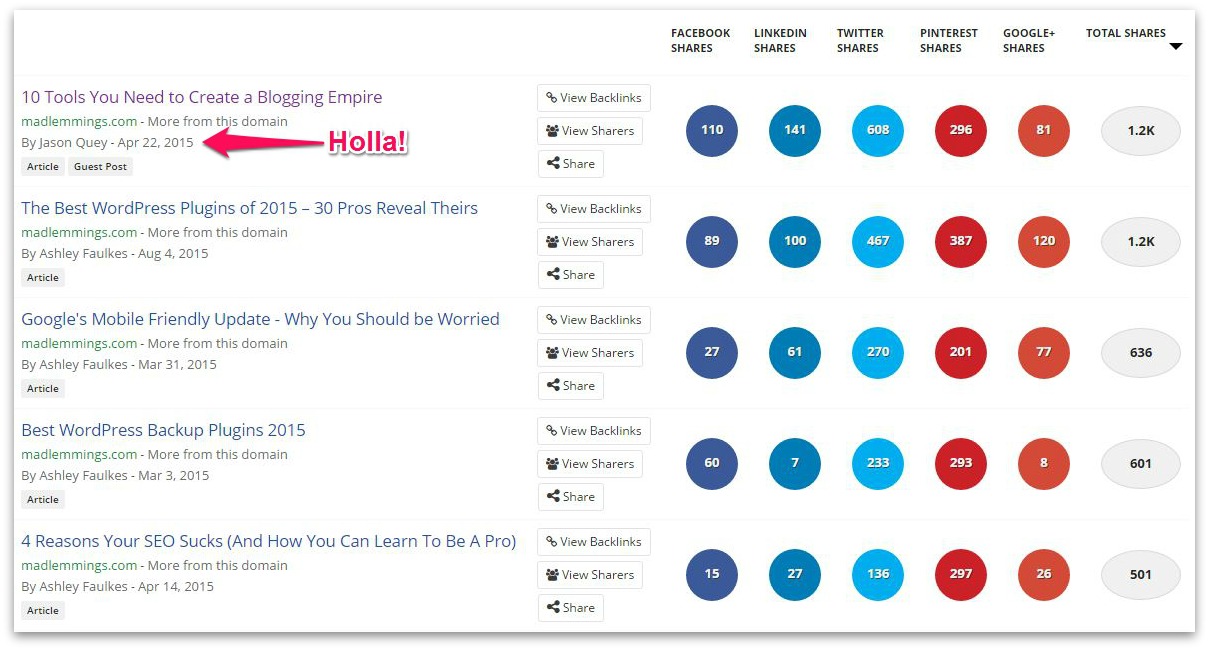
It also provided a nice traffic bump compared to his usual posts:
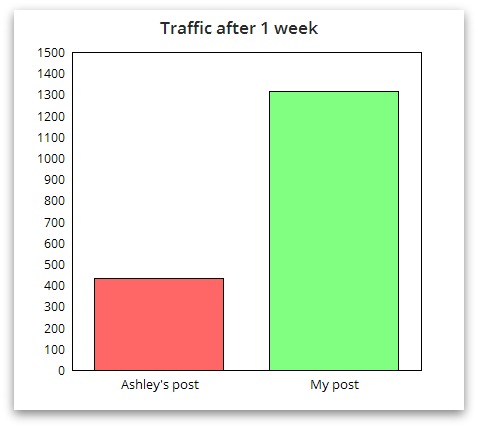
Surprised? I was too, until I realized I subtly used influencer marketing. The same key ingredient of expert roundups.
Don’t get me wrong: expert roundups can be effective.
But because everyone and their cousin does them, many marketers don’t promote the articles like they did back when they became popular c. 2013. It’s a bloody red ocean and impressing influencers ain’t easy to get them to help you out.
So how did I get influencers to promote the heck out of my content?
As much as we all hate it, research is your first step. Luckily, we can make it quick, easy, and painless. Here we go:
Know Who You Want to Target and Why
Before beginning an influencer campaign, I want to know three things:
- Is the influencer’s audience relevant for what I’m offering?
- What’s the influencer’s reach?
- What can I do to create value for the influencer?
1. Is the influencer’s audience relevant for what I’m offering?
A non-relevant influencer’s audience won’t convert nearly as well as a relevant one (such as reaching out to a fashion blogger an email about your article on dog grooming).
Even a relevant influencer who has a non-relevant audience isn’t worth pursuing. Plus, reaching out to an influencer who’s a bad fit might cause them to ignore your emails, making it more difficult the next time you reach out to them.
Personally, I’ve only measured relevancy by observing what they share on social media.
2. What’s the influencer’s reach?
Consider these words by management consultant Peter Drucker: “What gets measured gets managed.”
There are several ways to measure reach, but I focus on the social media impact, their email list size, website Domain Authority, and likelihood of future reciprocation. To keep things simple, I’d recommend just looking at their social reach.
How can you measure social impact?
As simple as it sounds, I get an average score of the person from Klout and FollowerWonk. Using the two together allows me to weed out most you don’t want.
Let’s say you want to know Noah Kagan’s social reach.
To find out his clout on Klout, locate Noah’s Twitter handle (@noahkagan), and add this to the end of Klout.com (i.e. “klout.com/noahkagan”). You will see he has a score of 65, which is a solid score (I notice those at 50 or above are worth reaching out to).
Over on FollowerWonk, I click the “search bios” tab and again search for his Twitter handle. Looks like Noah has a score of 62. Then after averaging the two scores (i.e. (65+62)/2), you arrive at the score 63.5.
This tells me Noah is a worthwhile influencer to connect with (again, being above 50) and he probably doesn’t have fake Twitter accounts artificially inflating his score. This might be the case if Noah’s Followerwonk score was abnormally higher than his Klout score.
Keep in mind: These numbers are easy to manipulate, so it may be helpful to observe the influencer.
One way you can do this is by using social monitoring tools like TweetDeck or Hootsuite (I prefer TweetDeck), you can see who has shared your article on Twitter.
For example, I can check who has shared my guide, “A Smart Guide to Getting “Influencer” Attention Online, Even if You Are A ‘Nobody’” by plugging in the URL into a search column, leaving out “http” or “www” which can affect the search parameters.
3. What can I do to create value to the influencer?
While there are many ways to add value to influencers, here are four strategies I’ve used.
A. Read their articles, implement, and share your results
A question I often ask myself while writing an article is, “Will this actually help anyone?”
My goal in blogging isn’t to simply write fancy words. My goal is to motivate people to take action.
I want to know that my advice isn’t just falling on deaf ears. So if someone were to email me and tell me about the results they’ve seen from implementing my advice, I’d be ecstatic!
Even better, you can…
B. Be their case study
Influencers love to hear how you’ve taken massive action, but they love it even more if they have a case study to share.
Why is this?
Well, case studies show other people that this process is repeatable and that results aren’t limited to just one person who has figured the system out.
This is part of the strategy I used to land my dream job with Sujan.
So after you’ve shared your results, offer to write a guest post for them, detailing your approach.
C. Write about them in a good light
If you are about to write an article about your industry, why not refer to the influencer and give your readers reasons to follow them?
Those of you who are observant probably saw several influencers I’ve included in this article. If they choose to share or link to it, great!
But even if they don’t, that’s fine. The end goal is to add value to them.
D. Make introductions
As you begin to connect with others, one of the best ways to add value to two people all the same time is to make introductions.
You can write an email like this:
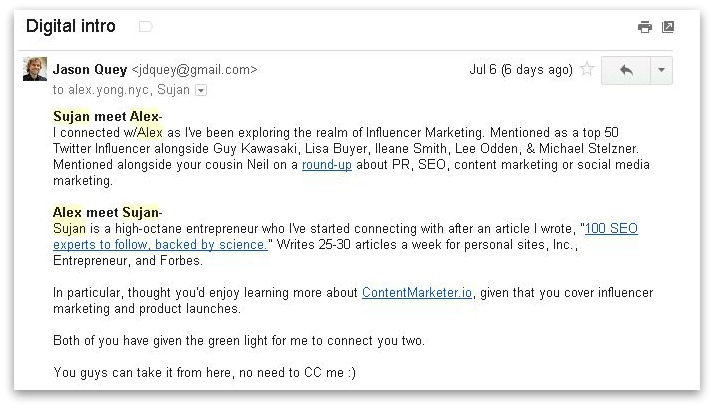
My goal was to put both parties in a great light and add context why they should connect.
Keep in mind though: What may be valuable to one influencer won’t be for another another. That’s why you must keep in mind the type influencer you are connecting with.
The 5 Flavors of Influencers (and How to Connect With Each)
Not every influencer is created equal. There are different types of influencers, and your approach with each type should differ.
I place influencers into 5 categories:
- Celebrities
- Authorities
- Journalists
- Connectors
- Bloggers
Each of these influencers have different things you need do to attract their attention. If you treat a celebrity like you do a connector, your results will be limited.
Celebrities
The opportunity to connect with celebrities are rare for the everyday folk. While they have a very high reach, they also have many people reaching out to them.
Neil Patel, Rand Fishkin, and Hiten Shah fit here, the Oprah Winfreys of Internet marketing. Unless you can move mountains for them, I’d recommend starting with another category.
That’s not to say you can’t reach them. Here’s how Steli Efti at Close.io landed an interview with Gary Vaynerchuk:

“If you insist on going after a celebrity, you have to think really long-term.
I tried to get in touch with Gary Vaynerchuk for years.
- I bought a unique domain and set up a website to get his attention.
- Emailed him. Again and again.
- Tried calling.
- Creatively leveraged my network and a series of follow-ups over several months to get Gary to commit to an interview.
Then it took several months of persistent follow-up to actually schedule the interview.
Eventually, I got my hour with Gary; and we did the interview.
Back in 2013, nobody knew who I was, nobody knew about our company. Gary? HUGE BRAND, HUGE AUDIENCE, multiple New York Times best sellers.
The interview not just gave us a lot of brand exposure, but also resulted in a lot of trial signups for our sales software and thousands of dollars in monthly recurring revenue.
Going after celebrities won’t be a quick win, but if you’ve got a strong follow-up hustle, it can pay off big.”
Authorities
Authorities also hold large sway over their audience, but tend to be easier to connect with than a celebrity. Their opinion is valuable to the industry. You will often see them speaking at conferences, writing books, and blogging.
Figure out what they are involved with and what you can do to move the needle. While you will have a challenge truly connecting with Neil, you may find his cousin Sujan easier to connect with.
When it comes to authorities in marketing, think of Lee Odden, Sujan Patel, and Brian Dean.
Journalists
Journalists can be anything from a celebrity to the everyday blogger.
When I connect with journalists, there’s usually two things they are most interested in: traffic to their article and exclusive information (which leads to more traffic), such as telling them about industry news and events before it’s released to the public.
Why do they value traffic? Because that’s often what their pay is based on.
Ash Read from PostReach and editor at Buffer explains:

When it comes to reaching out to journalists, the key thing I’ve learned is to think about it from their point of view.
Don’t think about how they can help spread the word about your startup. Instead, ask yourself how you can help them achieve their goals.
I’ve also found it helpful to show excitement in your message.
Nobody will care about your launch unless you give them a reason to. So it’s essential to convey your passion, and if possible, some proof others are excited too.
Things like:
- I’ve got 10,000 people who joined my beta.
- A Tweet teasing your product that received hundreds of Retweets.
Anything you have that’ll give the journalist a hint that people will want to read this story.
Another key: Keep your initial message short and punchy.
Instead of sending a 3,000 word pitch. I’ve also learned not to put too much pressure on a decision right away.
Asking “Is this something you’d like to cover?” could feel quite pushy. On the other hand, asking if the journalist agrees to an embargo doesn’t force them to make a decision.
Some marketing journalists I’ve enjoyed reading include Murray Newlands, John Rampton, and Aaron Orendorff.
Connectors
Connectors like to connect people together to create value. They’re difficult to find because you can’t see their work explicitly. But they often are a huge boom to your bottom line when you do.
I’ve found podcasters tend to fit into this category as they enjoy those personal, 1-on-1 conversations. To get more guests for their show, they begin connecting with more and more people.
For connectors, they enjoy receiving help in whatever project they are working on. If you can, connect them to other relevant influencers worth connecting with.
I place myself into this category alongside Andy Crestodina and Jayson Gaignard.
Bloggers
Finally, there are the bloggers. While they still hold sway, their impact is often limited to their blog audience. However, they are usually the easiest to connect with.
Simple wins with them include guest posting, linking to their site, and driving traffic to them.
Here’s a strategy that has worked well for Benji Hyam of Grow and Convert:
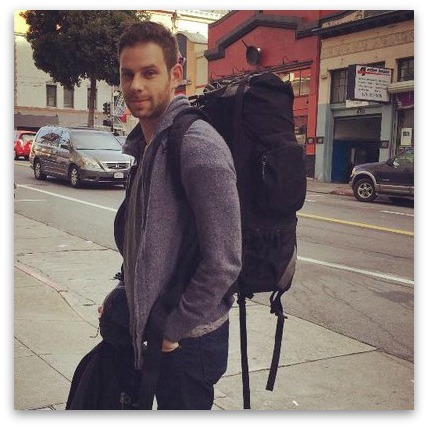
For bloggers and for authorities, the easiest way I’ve found to form relationships with them is to take their advice, test it out, and when something works share the results with them.
For example: They spend a lot of time writing, speaking and sharing ideas with people. They get little feedback from their audience when the advice they give others is implemented and helps someone accomplish something.
Then you reach out to them with a message like: “I read your article and implemented the advice you shared. These are the results that I achieved.”
I almost guarantee you’ll get a response from them.
When people reach out to me and say they’ve used something that I share, those are the first people I respond to.
Big name marketing bloggers include Adam Connell, Pauline Cabrera, and Johnathan Dane.
How do you know what category an influencer falls into?
My team at ContentMarketer partnered up with Venngage and Sumo to bring you this influencer marketing cheat sheet:

Finding Tons of Influencers to Connect With
Now you are aware of the basic ways to identify the influencers. How do you find them?
I use BuzzSumo and FollowerWonk to make a good starting list, and PostReach to validate their relevancy and impact. Here is a quick, step-by-step process you can use.
Remember: Not everyone listed is an influencer worth connecting with.
BuzzSumo
Here’s how to find a ton of influencers who have shared similar articles to the one you wrote.
- Type a couple keywords related to the influencer’s niche into BuzzSumo.
- Click on “view shares”
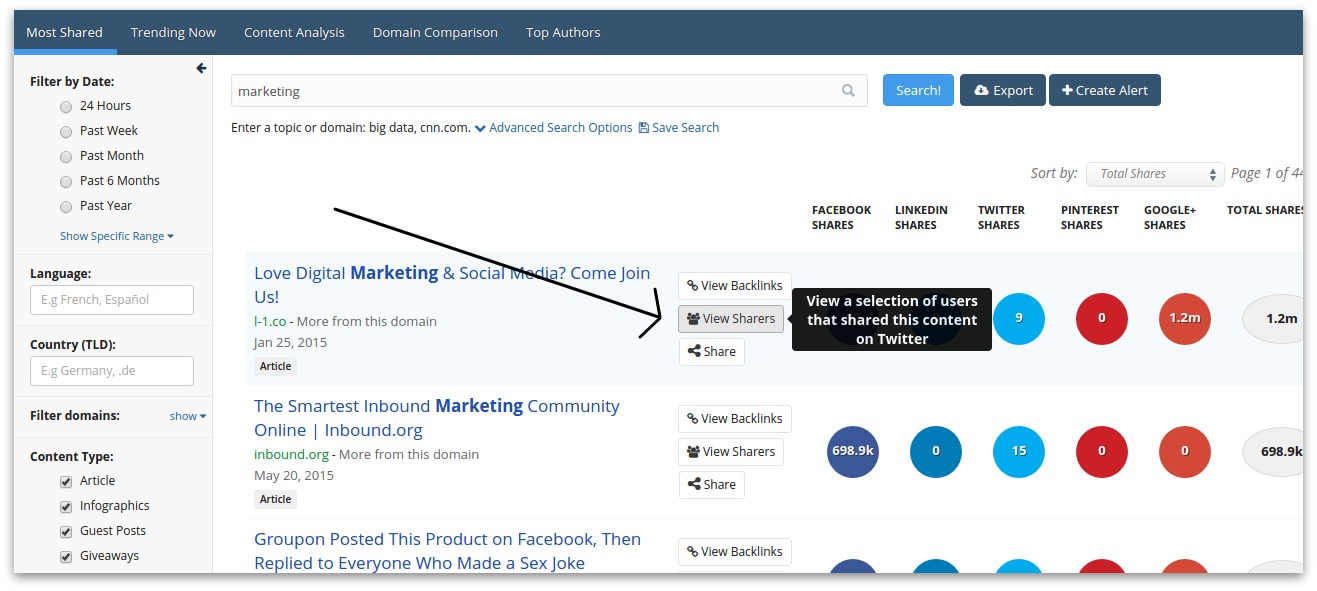
See all the awesome bloggers, influencers, companies, journalists, and regular ol’ folks who shared this piece.
FollowerWonk
FollowerWonk allows you to easily find influencers based on the influencers you already know.
1. Head to the “Compare Users” tab on FollowerWonk.

2. Plug in the Twitter handle of 3 of your favorite influencers

3. Click on each of the links of the followers shared by 2 or 3 of the influencers

I find this approach works best if each of the influencers aren’t following over 2,000 people, though it can still work if just one of them is following that many.
PostReach
I use Postreach to validate the relevance and impact of influencers. Here’s how to use it:
1. Login to PostReach.
2. Enter the URL of a highly-shared blog post from your niche

3. View sharers and see who all the awesome people who helped amplify this post
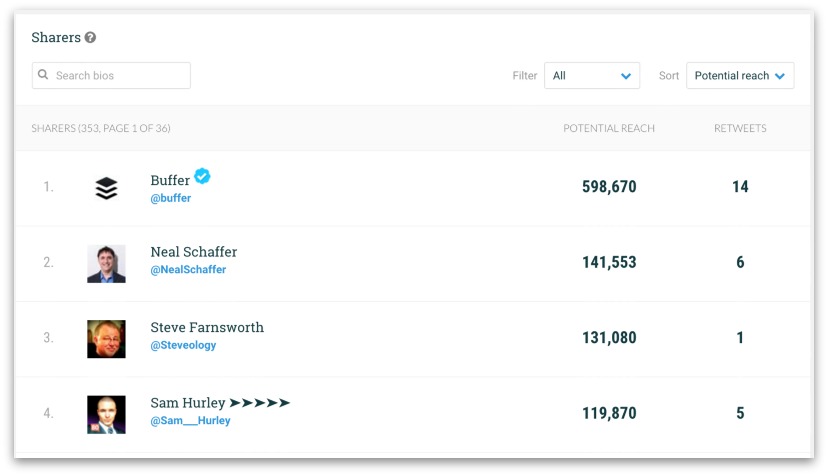
This is a new tool to the influencer marketing scene, but one worth checking out.
Remember that influencers are human, so they have multiple interests.
In the FollowerWonk example, Nat, Noah, and I have shared interests in various fields of internet marketing, startups, and entrepreneurship. So using this approach to find other content marketers might be a little harder.
Nat and I are also tea connoisseurs. Although this more of a secondary interest (i.e. we aren’t prolifically sharing about our tea habits on Twitter), there’s a chance we both may be following influential tea experts.
That would make your outreach very challenging if you wanted to share an article on how to grow your site from 0-10K to a tea expert.
Now that you know the right influencers to connect with, now it’s time to learn how to connect with them.
How to Meaningfully Connect with Influencers
After discovering the type of influencer you’re dealing with and how to find them, you need to learn how to connect with them to actually get results.
About a month ago, I received a tweet that I was an influencer in conversion rate optimization (CRO). Even though I don’t consider myself an expert, I decided to check out the article.
What did I find? A numbered list of 50 influencers and their respective Twitter handle. No information about who they are or why they are worth following. Please don’t do this.
Instead, you can try one of my three favorite strategies that have given me proven results time-and-time again:
1. Feature them in a quality article.
Instead of doing a large expert roundup, feature 3-5 experts that you really want to connect with. This shows the influencer you’ve done research on them and puts them in the limelight. For example, you can create an expert roundup and fill in your own thoughts about each person’s advice.
William Harris has a great example of this on the Sellbrite blog. When he switched from SaaS to eCommerce, he used this post to connect with 5 of the biggest names in eCommerce content marketing.
2. Link to them on a high profile site.
If you are just starting a new site, more than likely they won’t notice your new blog. Instead, guest post on a bigger site and mention them.
Aaron Orendorff did this with his guest post on CrazyEgg, “16 Helpful Copywriting Articles To Launch You Into Web Writing Greatness.”
By not only curating some of the best articles on copywriting, but by linking to each author, including a brief summary of why he enjoyed each piece, and a direct-quote insight, the post become more than a mere listicle.
3. Figure out what they want and give it to them.
Put yourself into the influencer’s shoes. What do they value?
Do they have a new project they are working on? Become an earlier adopter, a raving fan of the product, and share with them the results. This is how I landed dream jobs working with Sujan and Jonathan Dane (an authority influencer in the PPC and CRO space).
Another angle you can take: By helping out another influencer who knows them and start building relationships to the influencer you want to target.
Let’s say you wanted to connect with Sujan and Jonathan. You could find out what I want help with and shoot me an email. In doing so, not only would I want to help promote you, I would then vouch for you and make an introduction.
What would benefit a growth strategist? You’d be right if you guessed driving a substantial amount of traffic (i.e. 500+ visitors to an article) or create a notable backlink (i.e. DA 40+).
What if you still are not sure what they want? I’ve found making good educated guesses shows the influencer that you have given it some thought.
Consider this email I sent to Hiten Shah, Neil Patel’s co-founder:
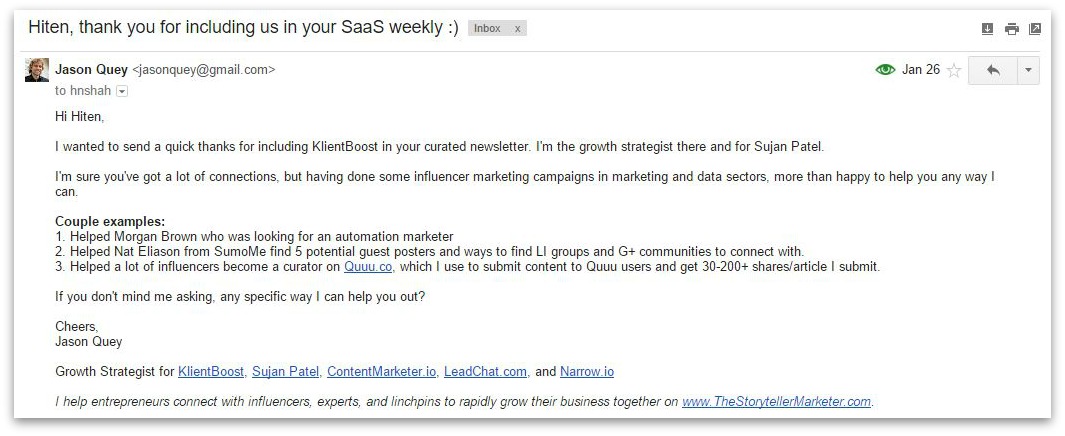
My reason to connect was to thank him for including us in his SaaS weekly.
If you noticed, since I’ve helped other people, I gave him specific examples of people and names he would know.
You may not be able to give names in the first email you send. But by giving them specifics shows that you can take initiative.
Here’s Hiten’s response:

Now the game was on. I knew what he wanted and needed to deliver on it. It took an exchange of 8 emails, but I was able to find a way to help drive traffic to his newsletter.
Once you’ve connected with these influencers, what can you do to get them to promote your content?
5 Promotion Strategies so Influencers Share You Work for You
At the end of the day, while it’s valuable to make meaningful relationships, it isn’t a form of marketing if you never promote your work.
Here are 5 strategies you can use with those newly minted relationships:
1. Beef up articles with expert quotes
An expert quote is a quote from an influencer in your field that provides an extra boost of authority (as you see I did above with Steli, Benji and Ash in the 5 Flavors of Influencers section above.
Shanelle Mullin was one of the first I observed doing this on ConversionXL. In her article, “How to Write Copy People Will Actually Read,” you can see how she highlights Sujan Patel. If I were Sujan, I’d promote that piece because of how well it highlights me.
“There are obvious promotional benefits, but the main reason I include expert quotes in my articles is because it’s genuinely helpful to our readers. I don’t reach out to the experts who have the most social influence, I reach out to the experts who are most qualified to offer useful advice on the topic.”
Focus on creating helpful, thorough content before you reach out to experts. Your quotes should complement the article, not the other way around.
Another example: The team at Orbit Media crushed it with their article 34 ways to get the most from a conference. A solid piece on it’s own, they then took things a step further by getting over 20 experts to providing their own insight.
You can also use this approach with a content upgrade, like an eBook.
Sid Bharath did this when he wrote 50 Shades of Growth for LemonStand. He connected with 40 influencers like Neil Patel, Sean Ellis and Noah Kagan. With their permission to include content they had already created, he found ways to incorporate it into the book.
The book was an instant success. It began trending on Inbound and GrowthHackers and was promoted by all the influencers.
It attracted over 3,000 new leads within the first week of its launch and continues to drive traffic, leads and links to LemonStand to this day.
2. Create a company roundup post
While individual experts may be tuckered out, many companies still seem fresh to share great content.
KlientBoost created a beautiful gifographic and article on the PPC food pyramid to help PPC marketers master paid promotion channels.
With over 50 companies listed, this provided a great opportunity for KlientBoost to:
- Build relationships with companies in their industry
- Have those companies share their article
- Get the gifographic in front of those that might link to it.
LeadChat did something similar by creating an ultimate business tool roundup. I find their approach to be more effective from a promotion point-of-view.
Why is the LeadChat article more likely to be promoted? They spent time giving key insights to the reader why they should consider each of those tools. That said, both are great articles to learn from and may be worth bookmarking to reference later.
You may be thinking “Jason, how do I reach out to companies?”
There are 3 ways I have found to be most effective:
- Find the press or PR email and reach out to them like you would an influencer.
- Use the contact box and send them a message.
- Tweet out a message.
I use Content Marketer to find the emails and contact box, Connector to send out the emails and automated with follow up messages, and Notifier to let them know through Twitter
Need a template to try out? Check this out:
Subject: Sending COMPANY some love on my latest post
Hey COMPANY!
I just created an article on TOPIC and included you guys in the article.
If interested in checking it out, here’s a link to the post: LINK
Keep up the great work! Would love any feedback when you get a chance.
Cheers, NAME
Just replace the all caps words with what you need and make some other minor tweaks to fit your writing style.
4. Do an expert roundup without their contribution
Huh? How do you do an expert roundup without getting their help?
Well, you start with the expert’s own words.
Taking a look at Aaron Orendorff’s Top 10 Copywriting Books from the Top 10 Online Copywriters, you’d never know that his number one copywriter — Brian Clark — was the only person on the list who didn’t actually contribute.
Instead, the book listed as Brian’s favorite, along with the quote, was taken from a previous post of Brian’s where he answered the same question.
Another example: I was doing the digital marketing for a web hosting startup, Decibite. I needed to figure out how to drive a ton of traffic to our site.
Decibite is geared to help professional internet marketers increase traffic and conversions. So I thought writing an article on the top 100 SEO experts in the world would help attract our target audience to our fledgling startup.
I did not want it to be one of those flimsy articles that just lists the experts and just tells the reader to “go follow them on Twitter.” Like most of my articles, I want them to be truly helpful and actionable.
Nor did I have time to email all of them to fill out their profile. So I did it for them.
The result?
Over 1,800 shares in 3 days. Not to mention links from Search Engine Land, SEMRush, and some of those marketers’ personal sites. Booyah grandma.

To prove it wasn’t a fluke, I created a similar article for Maptive on the top 100 big data experts to follow for 2016.
Even though Maptive has no share bar and no email list (I know, I cringe too…), just by reaching out to the influencers, we received over 22,000 visitors and several links, including 5 between DA 50 and 85 (two from .edu sites).
Ohhhhh yeah.
5. How to get an influencer to promote an article without including them
You’re crazy Jason!
Probably. But this tactic can triple the shares after the initial buzz dies down, so the results speak for themselves.
Here’s how to get influencer love without even including them:
- Use BuzzSumo to find relevant articles to your topic
- View everyone who shared those articles on Twitter
- Use Respona to find their email addresses (you may find success with Buzzstream and NinjaOutreach too, however I have not used these tools in this manner)
- Reach out to the influencers and ask for their feedback
- Watch the traffic come in like tweenage girls to a Bieber concert
This is how I promoted an “unsexy” article and took it from 202 to 711 shares in two weeks.
Some Parting Thoughts…
Another strategy that always does well is to involve influencers in the co-creation process itself. That’s what I did with this article, and I want to thank those who read and contributed to this masterpiece:
- Aaron Orendorff of iConicontent
- Sid Bharath of Thinkific
- Ramin Assemi of Close.io
- Nat Eliason of Sumo
- Sarah Peterson of Sumo
- Ash Read of PostReach and Buffer
- William Harris of SellBrite
- Benji Hyam of Grow and Convert
- Nadya Khoja of Venngage
- Shanelle Mullin of ConversionXL
- Danavir Sarria of CopyMonk
If you feel that this information may not apply to your field or wish to add something, leave me a comment below. I’d love to hear your input, even if you read this several months down the road.
And if you notice I don’t respond after a while, shoot me an email (jason [at] thestorytellermarketer.com).
Happy connecting!










Add A Comment
VIEW THE COMMENTS